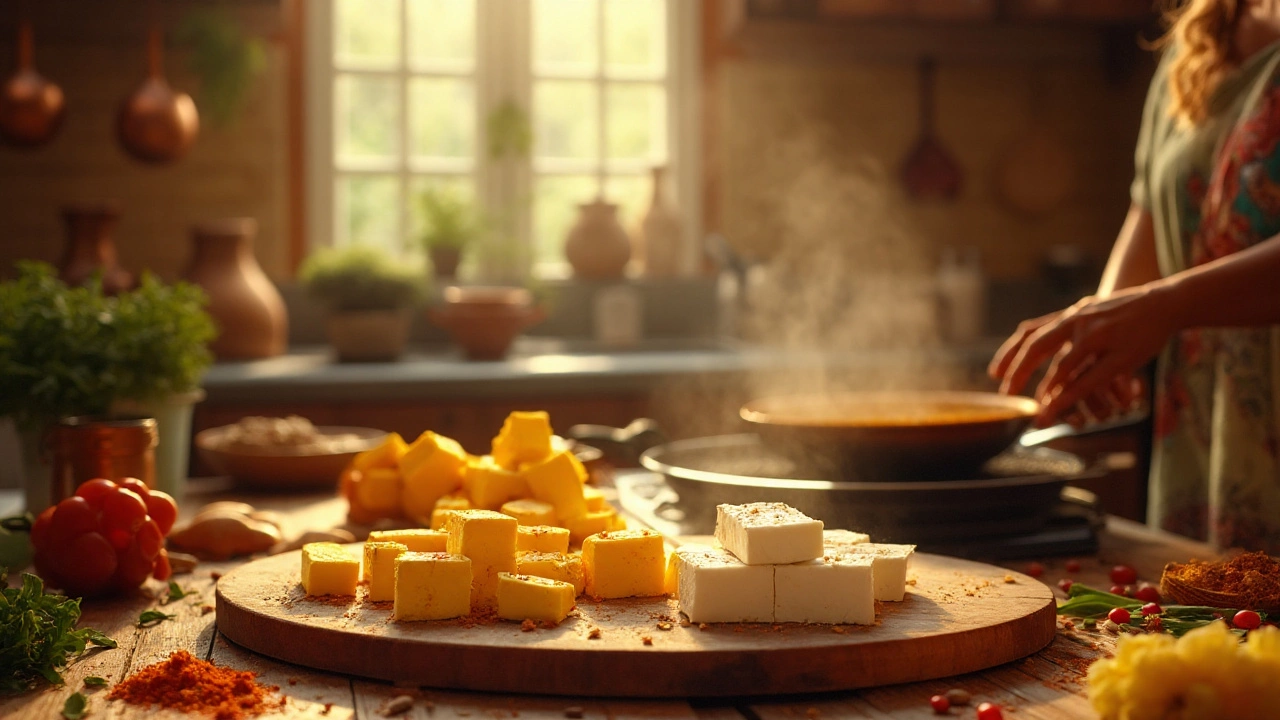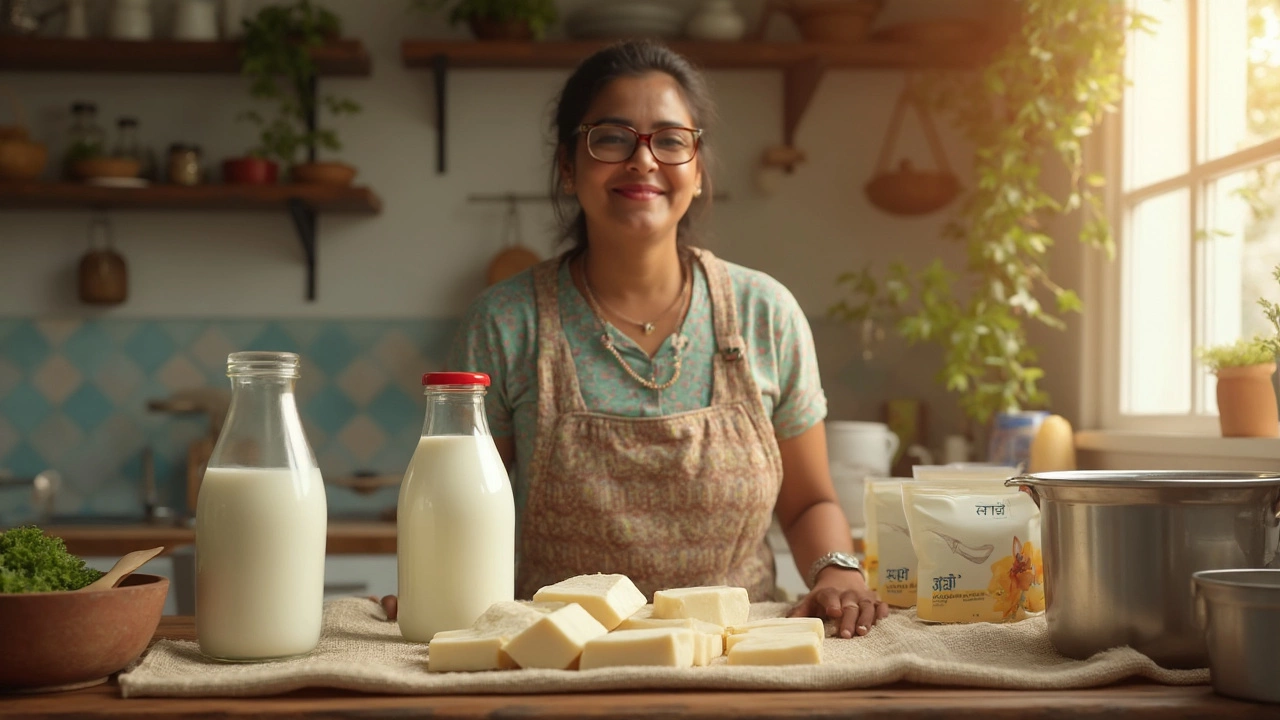Paneer: Indian Cheese Basics, Recipes & Tips
When working with paneer, a fresh, mild cheese produced by curdling milk with an acid like lemon juice or vinegar. Also called Indian cottage cheese, it is a staple in Indian cuisine and appears in countless curry dishes. As a high‑protein, low‑fat vegetarian protein, paneer lets home cooks add richness without meat.
Why does paneer matter in everyday cooking? First, its neutral flavor soaks up spices, making it perfect for everything from buttery masala to tangy tikka. Second, it holds its shape under heat, so you can grill, fry, or simmer without it breaking apart. Finally, it’s quick to make at home—just heat milk, add an acid, strain, and press. That simplicity means you can control texture, from soft crumbly cubes to firm grilled slabs.
How Paneer Fits Into Everyday Cooking
Most Indian home cooks start their day with a protein boost, and paneer fits right in. A handful of cubes tossed into dal or lentil soups adds body and balance. In breakfast, paneer can be crumbled into parathas or mixed with herbs for a filling omelette‑style scramble. For lunch or dinner, think of paneer as the canvas for regional flavors—north Indian mustard‑seed‑rich saag paneer, Gujarati‑style paneer bhurji, or the spicy, tangy flavors of a South Indian paneer chettinad.
Cooking technique matters. When you grill paneer, marinate it in yogurt, ginger‑garlic paste, and chili powder for at least 30 minutes; the acid tenderizes and the spices caramelize. If you’re simmering it in gravy, add the cubes halfway through cooking—this prevents the cheese from becoming rubbery. For a quick snack, pan‑fry lightly salted cubes until golden and serve with a squeeze of lemon. Each method changes texture and flavor, giving you multiple ways to keep meals exciting.
Spice pairing is another secret. Cumin, coriander, and garam masala are the go‑to trio, but you can experiment with smoked paprika for a deep, smoky note or fenugreek leaves for bitterness that cuts richness. When you combine paneer with tomatoes, the acidity balances the creamy cheese, a trick used in classic tomato‑based paneer masala. If you avoid tomatoes, coconut milk or cashew paste provides the same silkiness without the tang.
Storing paneer is easy but often misunderstood. Fresh paneer lasts about two days in the fridge if kept in its own whey or a light saltwater solution. For longer storage, cut into cubes, pat dry, and freeze in airtight bags; thaw in the fridge before using. This method retains firmness, making frozen paneer ideal for grilling later.
Health‑wise, paneer offers calcium, phosphorus, and B‑vitamins, supporting bone health and energy metabolism. It’s also a good source of casein protein, which digests slowly—great for sustaining muscle repair overnight. If you’re watching fat intake, choose low‑fat milk when making paneer, or crumble the cheese and blend with vegetables to stretch the protein further.
Regional variations show how versatile paneer can be. In Punjab, paneer gets mixed with grated potatoes and spices for a stuffing called paneer bhurji. In Kashmir, it’s layered between flaky pastry for a rich pastry called keema paneer. In Bengal, paneer is flavored with mustard oil and green chilies for a pungent side dish. These examples illustrate that paneer isn’t a one‑size‑fits‑all ingredient; it adapts to local palettes.
When you’re planning a menu, think of paneer as a bridge between vegetarian and non‑vegetarian meals. A platter of paneer tikka can satisfy meat‑eaters, while a spinach‑paneer curry satisfies vegans when you substitute dairy‑free cheese. This flexibility helps you cater to mixed groups without cooking separate dishes.
Beyond main courses, paneer shines in desserts. Sweet paneer gulab jamun, rasgulla, and cheesecake all rely on its mild sweetness and smooth texture. The same curdling process used for savory dishes can be tweaked with sugar and cardamom to create indulgent treats that still pack protein.
One common question: can you substitute paneer with other cheeses? The short answer is no for exact texture, but for flavor you can use tofu (for a vegan version) or halloumi (for a higher‑melting point). Each substitute changes the dish’s character, so experiment cautiously.
Finally, the paneer community online is buzzing with tips—like adding a pinch of baking soda during curdling to make softer cheese, or using a cheesecloth tightly to squeeze out excess whey for firmer blocks. These small tweaks can elevate a home‑made batch from decent to restaurant‑quality.
Below you’ll find a curated list of articles that dive deeper into paneer’s role across Indian cooking, from classic dishes to modern twists. Whether you’re a beginner looking to make your first batch or an experienced cook hunting for new flavor combos, the posts ahead have something for you.

Paneer vs Tofu: Which Tastes Better?
Explore the flavor, texture, nutrition, and culinary uses of paneer and tofu to decide which one wins the taste test for your kitchen.

Which Milk is Best for Paneer Making? Key Choices Explained
Wondering which milk works best for making paneer at home? This article breaks down different types of milk and their impact on the taste, texture, and yield of paneer. Get practical tips, bust some myths, and find out what local dairies never tell you. Plus, learn how to avoid the most common mistakes when choosing milk. By the end, you'll have everything you need to make soft and fresh paneer every time.

How Lemon Transforms Milk for Homemade Paneer Magic
Adding lemon to milk causes it to curdle, a fundamental step in making paneer at home. This process separates the milk into curds and whey, enabling the creation of a fresh, homemade cheese. Understanding how lemon acts on milk can enhance your paneer-making skills and offer better results. Explore the science behind this reaction and discover tips on achieving the perfect texture for your paneer. Dive into the world of homemade paneer and enjoy a truly rewarding culinary experience.